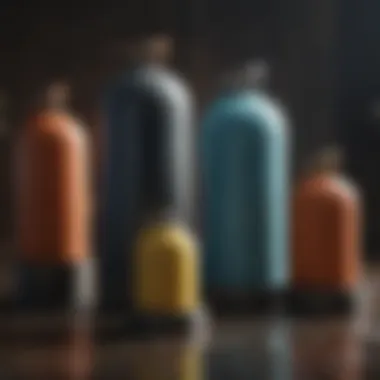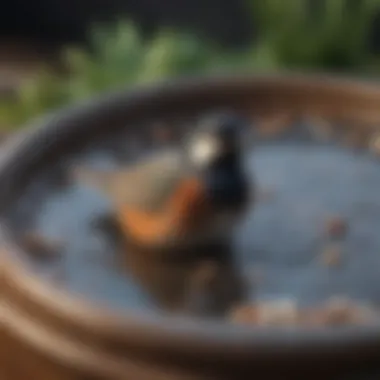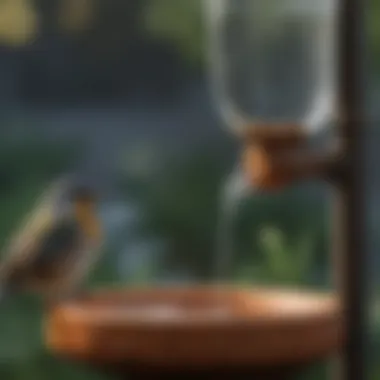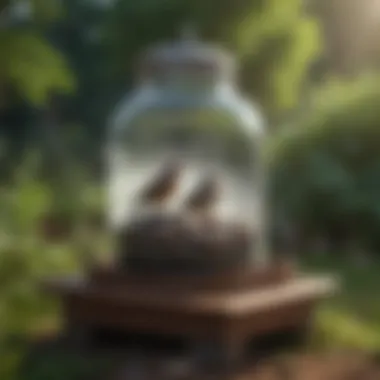Ultimate Guide to Bird Water Containers: Types and Care


Intro
Water containers are essential for birds, providing not only hydration but also enhancing their overall well-being. This guide unpacks the vital aspects of selecting and maintaining water containers specifically for your avian companions. By understanding their needs and the various options available, bird owners can ensure their pets remain healthy and comfortable.
Understanding Your Pet
Pet Behavior Basics
Birds are intelligent creatures that display a variety of behaviors influenced by their species and environment. Understanding basic behavior helps in catering to their needs. For instance, birds often prefer shallow waters, which mimic natural sources. Observing how your pet interacts with water is key. Some may enjoy splashing, while others prefer a clean still surface.
Common Breed Characteristics
Different bird species have unique traits affecting their water needs. Parakeets and cockatiels, for example, may require frequent access to fresh water, while larger species like cockatoos may be messier and need more frequent cleaning of their water containers. Recognizing these traits informs the choice of water container that best suits your pet.
Species-Specific Needs
Hydration needs vary significantly among bird species. For finches, small bowls may suffice, while parrots might benefit from larger containers or even small fountains that encourage play and exploration. Researching specific requirements based on your bird's species can help in selecting the right water container.
Selecting the Right Water Container
Types of Water Containers
Bird owners will find a variety of containers suitable for their needs. Common types include:
- Bowls: Simple and effective, made from ceramic or plastic.
- Fountains: Circulate water to keep it fresh. Ideal for larger birds.
- Waterers: Bottles or tubes that release water as needed, minimizing mess.
Material Considerations
Selecting the right material is crucial for hygiene and durability. Ceramics are easy to clean and do not leach chemicals. Plastic containers should be BPA-free. Stainless steel options are durable and also maintenance-friendly.
Design and Usability
When choosing a water container, consider the design and function. Ensure it is stable and hard to tip over. Some birds are adventurous; a low-profile design works best to avoid spills. The ease of cleaning should also factor into your decision. Containers that can be easily disassembled will make routine maintenance less of a chore.
Maintaining Water Containers
Daily Cleaning Routines
Keeping water containers clean is essential. Bacteria can grow quickly in stagnant water. Change the water at least once daily and clean the container with mild soap weekly to remove any residue. Rinse thoroughly to remove all soap traces, as birds are sensitive to chemicals.
Seasonal Adjustments
Different seasons may affect how often you need to clean water containers. In warmer months, algae growth may be a concern, necessitating more frequent changes. In winter, ensure that water does not freeze, using heaters if necessary.
End
Preamble to Water Containers for Birds
Water containers play a critical role in avian health and comfort. Birds require access to fresh water daily for drinking and bathing. A proper water container supports their hydration needs and promotes their overall well-being. As pet owners, understanding the essentials around water containers can improve the care we provide.
Importance of Hydration for Birds
Hydration is vital for birds, as it impacts their digestion, feather quality, and energy levels. Birds, much like other animals, rely on water for various bodily functions. Without sufficient water intake, they might suffer from dehydration, which can lead to severe health problems.
It's noteworthy that different species of birds have various hydration requirements. For instance, small birds require less water than larger species. Knowledge of these needs allows you to cater to your bird’s specific hydration demands, ensuring they remain healthy and active.
Overview of Water Container Options
When it comes to water containers, there are several options available, each with pros and cons. The right choice will depend on your bird species, environment, and personal preference. Common types include bowls, automatic feeders, hanging waterers, and bird baths.
- Bowls and Dishes: These are the most common and allow easy access for birds. They come in various materials such as plastic, ceramic, and glass.
- Automatic Waterers: These devices refill automatically. They require less frequent maintenance and can be helpful for busy bird owners.
- Hanging Waterers: These containers offer elevated access, reducing the chance of contamination from the ground. However, they may require careful installation.
- Bird Bath Options: Bird baths cater to both hydration and bathing needs. Seasonal considerations can influence your choice to keep water available year-round and offer birds a safe area for bathing.
Choosing the right water container ensures that your bird remains hydrated and healthy. Proper hydration contributes positively to your bird’s quality of life.


Types of Water Containers
Choosing the right type of water container is vital for the health and well-being of birds. Each type has its unique features and benefits, addressing specific needs for hydration. Understanding these options helps pet owners select the best fit for their avian companions.
Bowls and Dishes
Material Choices
When it comes to material choices for bowls and dishes, several options are available. Common materials include ceramic, plastic, and stainless steel. Each provides distinctive advantages.
Ceramic is durable and often available in beautiful designs, making it a popular option. Its heavy base resists tipping, which is crucial for active birds. Plastic, on the other hand, is lightweight and economical. However, it may scratch easily, which can harbor bacteria over time. Stainless steel is resistant to rust and easy to clean, but it can be heavy for smaller birds.
Given these factors, ceramic is often favored for its aesthetic appeal and stability, while stainless steel is valued for its durability and hygiene.
Design Variations
Design variations in bowls and dishes can significantly influence their functionality. Shallow designs allow easy access for drinking, while deeper bowls may provide more water but can complicate access.
Another aspect is the rim style. Some bowls feature a wider rim, making it easier for birds to perch while drinking. Additionally, anti-slip bases are beneficial in preventing spills.
Choosing a dish that matches the birds’ natural behavior can enhance their drinking experience, supporting their hydration needs effectively.
Automatic Waterers
Functionality
Automatic waterers provide a continuous water supply for birds, ensuring they always have access to fresh water. These devices use gravity or pressure to refill the water as birds consume it.
One key characteristic is their ability to reduce the frequency of manual water changes. This is particularly advantageous for busy pet owners. Moreover, it minimizes the chance of water impurities affecting the birds. However, these devices require a reliable water source and proper installation.
Maintenance Requirements
While automatic waterers are low effort in providing constant hydration, they do have maintenance requirements. Regular cleaning is necessary to avoid algae buildup and prevent contamination.
User manuals usually offer guidance on how often to clean. While they reduce some daily work, owners must adapt to the need for routine checks. This balance ensures birds receive clean, fresh water consistently.
Hanging Waterers
Benefits of Elevated Access
Hanging waterers have distinct benefits, especially regarding elevated access. By placing water containers off the ground, they reduce contamination risks from debris and droppings.
Elevated designs also often encourage birds to spread their natural behaviors, such as flying and perching. Additionally, these can be advantageous in outdoor setups, where ground moisture can contaminate ground-level sources. Birds can remain healthy with easier access to clean water away from ground pollutants.
Potential Issues
Despite the benefits, hanging waterers are not without potential issues. One concern is stability. If not securely fastened, the waterer may sway or tip, causing spills.
Moreover, maintenance can be more challenging. Owners may need a ladder or other tools to refill and clean the waterers. This added difficulty can be a deterrent for some, particularly in a busy household. Assessing these factors helps ensure that the benefits outweigh the potential challenges.
Bird Bath Options
Seasonal Considerations
Bird baths serve multiple purposes, including drinking and bathing. Seasonal considerations are essential when selecting a bird bath. In summer, shallow basins with broad surfaces allow birds to splash and cool off.
During winter months, heated bird baths prevent freezing, ensuring access to water despite low temperatures. Evaluating the specific needs based on the surrounding climate greatly enhances the utility of bird baths.
Outdoor vs.
Indoor Use The choice between outdoor and indoor bird baths can influence birds' health and happiness. Outdoor baths are great for visitors like wild birds. However, they must be protected from predators and environmental factors.
Indoor baths provide controlled conditions, reducing contamination risks. Yet, they might not attract wild birds. Understanding the purpose and environment informs which option best suits the needs of the birds being cared for.
Factors to Consider When Choosing a Water Container


Choosing the right water container for birds involves several factors that greatly influence both the practicality and the overall health of the birds. Understanding these elements ensures that the selected container meets the needs of various bird species while providing an optimal hydration source. Important factors include material suitability, size, capacity, and accessibility. Each of these aspects contributes not only to the satisfaction of bird owners but also to the well-being of their avian companions.
Suitable Materials
Durability
Durability is crucial when selecting water containers for birds. A durable container can withstand the wear and tear of everyday use. Common materials for durability include high-quality plastics and metal. These materials resist breakage and can last for a long time, proving to be a cost-effective choice. Choosing a durable option reduces the need for frequent replacements, ensuring that the birds have consistent access to water. However, some materials may become damaged due to prolonged exposure to the weather if placed outdoors.
Non-Toxic Options
Non-toxic options are essential for ensuring the safety of birds. When selecting a water container, it is vital to choose materials free from harmful chemicals. BPA-free plastics and untreated wood are good examples of non-toxic materials. Such options provide safety without sacrificing functionality. The unique feature of non-toxic materials is that they do not leach harmful substances into the water, which is critical for the health of the birds. Non-toxic options, while generally more expensive, prioritize the well-being of the pet.
Size and Capacity
Bird Species Requirements
Different bird species have unique water requirements. Small birds like canaries may need shallow dishes, while larger birds such as parrots require deeper bowls. Understanding specific species needs assists in selecting the proper size and capacity. A suitable container prevents over-spillage or inadequate water access, which is vital for hydration. Consult with avian experts to determine the best practices for each type of bird.
Space Constraints
Space constraints play a vital role in selecting a water container that fits in a particular environment. For urban bird owners, the availability of space may dictate the type of container used. Compact designs can fit within smaller cages or balcony setups, while larger outdoor spaces may allow for bigger water baths. The unique feature of accommodating space constraints ensures that the water container is easily integrated into the living environment without becoming intrusive. Additionally, it promotes better organization and cleanliness in housing areas.
Accessibility for Birds
Ease of Use
Ease of use encompasses how simple it is for birds to access water. Containers should be designed in a way that allows birds to easily drink without difficulty. Shallow bowls and wide openings enhance accessibility for various bird species. The primary benefit of providing easy access is that it ensures that birds can hydrate regularly. Containers that are difficult to reach may lead to dehydration, especially in smaller species that may struggle with higher walls or narrow openings.
Safety Features
Safety features are another critical aspect of water container design. Containers should be stable and not easily tipped over. Additionally, edges should be smooth, preventing injury to birds. Many waterers are designed with safety features such as weighted bases and protective guards. These features encourage safe drinking practices and help keep the environment secure for the birds. Investing in containers with these safety attributes can greatly reduce the risk of accidents.
Selecting the right water container is a critical part of bird care. It ensures that they have a reliable source of hydration, which is essential for their overall health.
Maintaining Water Quality
Maintaining the water quality in containers for birds is crucial for their health and well-being. Water serves as a fundamental resource that supports various bodily functions, including hydration and digestion. Dirty or stagnant water can harbor harmful bacteria, parasites, and algae. Thus, ensuring clean water is essential for preventing illnesses and promoting overall bird health. Factors such as temperature, sunlight exposure, and material of the container can all affect water quality. Addressing these conditions involves regular maintenance practices that keep the water fresh and safe.
Routine Cleaning Practices
Routine cleaning of water containers should be a priority for any bird owner. It is recommended to wash containers at least once a week, or more frequently if the water gets dirty. Use warm, soapy water to scrub the container thoroughly. A non-toxic soap is key to ensuring that no harmful residues remain. After scrubbing, rinse with clean water several times to eliminate any soap residue. This method will help prevent bacterial growth and limits the buildup of algae.
Tips for Cleaning:
- Use a soft brush to avoid scratching the surface.
- Clean under areas that are less visible, where dirt can accumulate.
- Consider soaking containers in a white vinegar solution for extra sanitization.
Preventing Contamination
Preventing contamination in water containers is equally important. Insects, dust, and debris can easily fall into the water and introduce harmful pathogens. Keeping the area surrounding the water container clean is essential. Avoid placing water sources near areas where droppings might fall, such as feeding stations or high-traffic bird areas.
To further minimize risks, consider using a lid or screen to keep out debris while allowing birds access. These covers should be securely fitted and made from materials that are easily cleaned. Also, evaluate the surrounding environment. For example, ensure that areas are not overly damp or muddy, as these conditions can encourage the growth of harmful microorganisms.
Changing Water Regularly
Regularly changing the water is an effective technique for maintaining quality. Water should be replaced at least once every few days. However, on hot days, changing the water every day may be necessary. Stagnant water is prone to bacteria and algae growth. Additionally, changing water more frequently benefits less active bird species that might not drink as often.
The frequency of water changes can also depend on other factors such as the weather and the number of birds. If you have a larger collection of birds or experience higher temperatures, more frequent changes will be necessary. Ultimately, a consistent schedule for water changes supports a cleaner drinking source and promotes better hydration among birds.
Important note: Regular maintenance of water containers enhances not only the health and comfort of birds but also the enjoyment of birdkeeping itself.
Health Implications of Proper Hydration
Proper hydration is essential for the health and well-being of birds. Water plays a crucial role in many physiological processes. It contributes to digestion, skin and feather health, and overall behavior. In this section, we will explore these aspects in detail, highlighting how adequate water supply can foster a healthier life for our avian companions.


Impact on Digestion
Water is vital for the digestive system of birds. It aids in the breakdown of food, allowing for better nutrient absorption. When birds have access to plenty of clean water, they can process their food more efficiently. This has several implications:
- Nutrient Assimilation: Proper hydration helps in the transport of nutrients through the bird’s body. When birds are dehydrated, their digestive efficiency declines, which can lead to malnourishment.
- Preventing Constipation: A sufficient water supply prevents issues like constipation. Birds need water to keep their digestive tracts functioning smoothly.
- Metabolism Regulation: Water impacts the metabolism and energy levels of birds. Dehydrated birds may experience fatigue and reduced activity, directly affecting their health and quality of life.
Ensuring that birds have access to fresh water can support their digestive health and optimize their nutrient intake.
Skin and Feather Health
The skin and feathers of birds are sensitive indicators of their overall health. Hydration plays a key role in maintaining the integrity of both.
- Feather Structure: Water is essential for developing and maintaining high-quality feathers. Well-hydrated birds tend to have shinier and more resilient feathers. Feather quality affects insulation and aerodynamics, which are crucial for flight.
- Skin Condition: Proper hydration supports healthy skin by preventing dryness and flaking. Dehydrated birds may experience dry, cracked skin, leading to discomfort and potential infection.
- Bathing Behavior: Many birds engage in bathing as a means to keep their feathers clean and hydrated. Access to suitable water containers is necessary for encouraging this natural behavior.
Regular access to water not only ensures proper hydration but also promotes ideal skin and feather condition.
Behavioral Benefits
Access to water influences bird behavior significantly. Behavioral changes due to hydration status can reveal a lot about their needs.
- Social Interactions: Birds often gather around water sources, enhancing social dynamics. This communal behavior fosters interactions, which are important for companionship and health.
- Stress Reduction: Birds that are well-hydrated tend to show less stress. They are more likely to engage in normal activities like singing and playing. Dehydrated birds may display signs of stress or lethargy.
- Exploratory Behavior: Hydration helps stimulate curiosity and exploration. Birds are more likely to engage with their environment when they are comfortable and well-hydrated.
As a conclusion, maintaining proper hydration in birds has profound implications. It impacts digestion, skin and feather health, and behavior. By ensuring access to fresh water, bird owners can support the overall welfare of their companions.
Common Mistakes in Bird Water Provisioning
Providing water for birds involves more than simply filling a bowl. Understanding common mistakes in water provisioning is essential for ensuring that birds remain healthy and hydrated. Missteps can lead to serious health issues for the birds and diminish the quality of their living environment. Highlighting these common mistakes can help bird owners prevent potential problems and create a safer space for their avian friends.
Inadequate Water Supplies
One major mistake bird owners often make is providing inadequate water quantities. Birds require an ample supply of fresh water at all times. Insufficient water can lead to dehydration, which may cause serious health problems. The amount of water needed varies with the species; a small finch needs less than a larger species like a cockatoo. Regularly check water levels throughout the day, especially during hot weather.
Regularly monitor the supply in the container and refill as needed. A good practice is to have multiple water sources available for your birds. This ensures that they have access at all times, especially if they prefer to drink from different locations.
- Birds can be very particular about their water sources.
- Some may prefer to drink from bowls, while others may like automatic systems.
Ignoring Weather Changes
Weather plays a significant role in bird hydration needs. Many bird owners do not take weather changes into account, leading to improper water provisioning. During summer, birds may drink more due to increased temperatures. Conversely, during colder months, water can freeze, making it unavailable.
Monitor the weather and make adjustments as necessary. Use insulated water containers in winter to keep the water from freezing. In hot summer months, refreshing the water multiple times a day can keep it appealing and cool.
Birds adapt to various conditions, but they still need support from their owners. By paying attention to changing weather, owners can significantly impact their birds' well-being.
Neglecting Cleaning Routines
Cleanliness is crucial in maintaining water quality. Many people forget to clean water containers regularly. Dirty water can harbor bacteria, algae, and other harmful organisms that can affect a bird's health. Using soap and water to clean bowls should be routine. Ideally, clean water containers every few days and change the water daily.
A few tips for effective cleaning include:
- Use a separate brush for cleaning bird water containers.
- Rinse thoroughly to remove any residue.
- Dry containers before refilling to prevent algae growth.
By addressing these common mistakes in bird water provisioning, owners can ensure a healthier and more enjoyable environment for their avian companions.
Culmination
In this article, the importance of selecting the right water containers for birds has been emphasized throughout. Proper hydration is crucial for the overall well-being of avian companions. By understanding the various types of water containers available, such as bowls, automatic waterers, and bird baths, pet owners can make informed choices that cater to the needs of their specific bird species.
Additionally, maintaining water quality is key. Routine cleaning and regular water changes prevent contamination, which can lead to health issues for birds. Keeping water accessible and fresh encourages birds to drink more, positively impacting their health.
The discussion also shed light on common mistakes in bird water provisioning. Inadequate water supplies, neglecting to consider weather changes, and poor cleaning practices can all harm birds. Addressing these issues is essential for avian welfare.
Remember: A suitable water container not only supports hydration but also creates a more enjoyable environment for birds.
Summary of Key Points
- Hydration is Essential: Birds need adequate water for health.
- Various Containers: Different types serve unique purposes (e.g., bowls, automatic systems).
- Maintenance Matters: Regular cleaning and water changes are vital.
- Mistakes to Avoid: Awareness of common errors can enhance bird care.
Final Thoughts on Bird Water Containers
Selecting the right water container for birds is not just about the container itself. It also involves understanding the needs of the bird species one cares for. Each type of water container offers distinct benefits that can enhance a bird’s living conditions. By choosing wisely, ensuring cleanliness, and adapting to changing conditions, pet owners can promote health and happiness for their birds. Investing time in understanding these aspects simply elevates the care provided to our feathered friends. A thoughtful approach to hydration contributes to a fulfilling bird-keeping experience.







